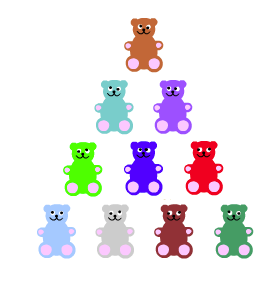Skip over navigation
Printable NRICH Roadshow resource.

Or search by topic
Number and algebra
Geometry and measure
Probability and statistics
Working mathematically
Advanced mathematics
For younger learners
Share Bears
Age 5 to 7
Challenge Level 





 Yasmin and Zach have some bears to share. Which numbers of bears can they share equally so that there are none left over?
Yasmin and Zach have some bears to share. Which numbers of bears can they share equally so that there are none left over?
Can they share one bear equally? Can they share two bears equally? Three bears? Four bears...?
What do you notice about the numbers they can share fairly? It might help to look at a number line and mark the numbers that do share fairly onto it. Do you notice a pattern?
How about using a 100 square?
Printable NRICH Roadshow resource.
You may also like
Biscuit Decorations
Andrew decorated 20 biscuits to take to a party. He lined them up and put icing on every second biscuit and different decorations on other biscuits. How many biscuits weren't decorated?

